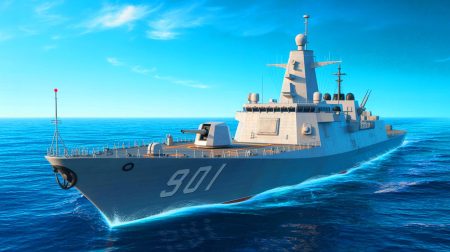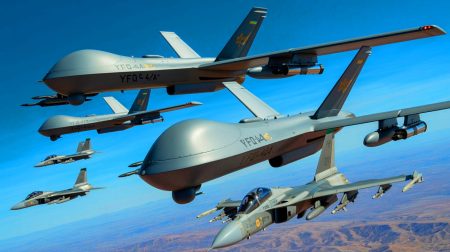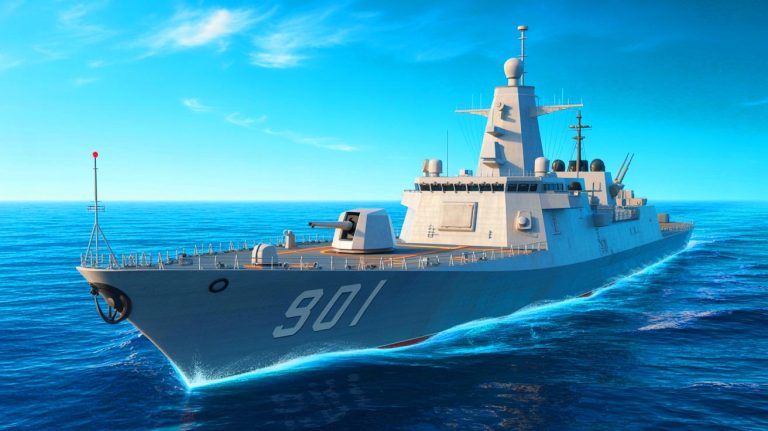| IN A NUTSHELL |
|
China’s People’s Liberation Army Navy has taken a groundbreaking step in naval warfare by integrating artificial intelligence (AI) into its degaussing operations, achieving a remarkable 60% improvement in efficiency. This advancement is not just a technical feat but a strategic move that could redefine naval stealth and operational readiness. As magnetic warfare becomes increasingly significant, this development marks a pivotal shift in how modern navies prepare for and engage in maritime combat. By reducing the magnetic signature of their warships, the Chinese Navy has set a new benchmark for stealth capabilities, potentially altering the dynamics of naval power globally.
Removing Warship’s Magnetic Field
The process of degaussing is essential for maintaining the stealth and safety of warships. Over time, a ship’s hull can become magnetized due to constant exposure to the Earth’s magnetic field and mechanical operations onboard. This magnetization poses a significant risk, making the ship vulnerable to magnetically activated weapons and detection systems. Traditionally, navies have relied on specialized equipment such as magnetic detectors and degaussing coils to counteract this magnetism. However, these methods require precise calibration and coordination, often consuming valuable time and resources.
With the integration of AI, the Chinese Navy has revolutionized this process. During a recent drill, the PLA deployed a Type 054A guided missile frigate to simulate battle damage. An emergency degaussing unit, equipped with magnetic sensors and a degaussing apparatus, was rapidly deployed. This exercise not only tested the technical viability of AI in field conditions but also validated the rapid deployment protocol under combat-simulated stress. The AI-assisted operation significantly shortened the degaussing timeline, allowing for quicker redeployment of vessels, thereby enhancing combat readiness.
China and AI
The role of AI in optimizing the degaussing workflow cannot be overstated. According to Chinese military analyst Song Zhongping, AI enhances the process by identifying optimal degaussing patterns and quickly verifying the success of magnetic field neutralization. This automated calibration replaces the slower manual methods, directly contributing to a vessel’s combat survivability and fleet-level resilience. The use of AI has led to a 60% increase in operational efficiency, an unprecedented gain for such a technically complex task.
As highlighted by China’s state broadcaster CCTV, this development is part of a broader emphasis on magnetic warfare, where controlling the electromagnetic spectrum, including magnetic signatures, is becoming a decisive factor in maritime operations. By leveraging AI, the PLA is not only enhancing its current capabilities but also setting the stage for future advancements in naval warfare. This move reflects a strategic foresight in preparing for the complexities of modern maritime conflicts.
PLA Drills
The recent exercise also introduced a new model of personnel integration within the PLA. Twelve recruits, most under the age of 23, were embedded in the emergency support unit. This approach of simultaneous training and operational deployment illustrates the PLA’s evolving strategy for force generation. By immersing recruits in high-risk scenarios and integrating them into critical roles from the outset, the PLA aims to shorten the time between training and combat readiness.
Liu Yunhe, a young sailor involved in the operation, expressed the pressure and urgency of frontline duty upon activating the degaussing system. Senior officer Sun Hui explained that including recruits in operational drills is a strategic move to accelerate the development of effective combat personnel. This method supports the PLA’s broader modernization efforts, highlighting how both AI and human resources are reshaping naval logistics and survivability in high-threat environments.
Significance for Naval Strategy
The integration of AI into naval operations signifies a paradigm shift in maritime strategy. By enhancing the speed and precision of degaussing, the PLA is setting new standards for naval engagements. This capability not only improves stealth but also ensures quicker turnaround times for damaged vessels, thereby maintaining a higher level of fleet readiness. The emphasis on speed, stealth, and precision underscores the growing importance of technological advancements in determining naval superiority.
As other nations observe these developments, the question arises: How will global naval powers respond to this technological leap? The implications of AI in naval warfare extend beyond immediate tactical advantages, potentially influencing future maritime doctrines and defense policies worldwide.
In an era where technological advancements are rapidly transforming military capabilities, China’s integration of AI into naval operations raises important questions about the future of warfare. As the world watches, will other nations follow suit in embracing AI for military applications, or will they find alternative methods to maintain strategic superiority on the high seas?
Did you like it? 4.6/5 (25)







Wow, a 60% reduction in magnetic signature? That’s impressive! How long before the US follows suit? 🤔